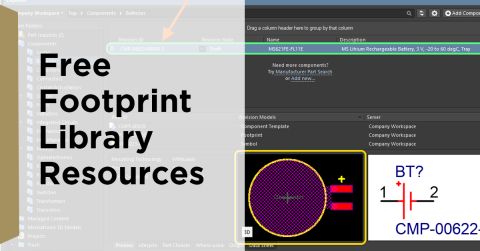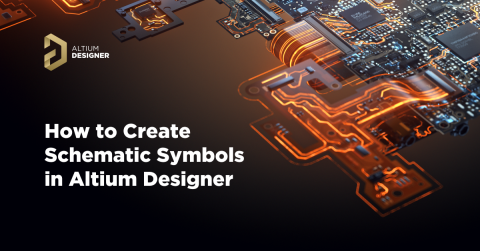Top 10 Electronics Components Every Engineering Student Must Know

Understanding the fundamental components of electronics is crucial for any engineer. Whether you're starting your first project or refining your skills, knowing these components will enhance your ability to design and build effective circuits. This guide will help you understand the key components you’ll often encounter throughout your electronics design journey. It also explains how to use resources from the Student Lab—like the Mouser Electronics modules that are now part of the Altium Education curriculum—to bring your projects to life.
These are the ten essential components every student engineer should be familiar with:
1. Resistors
The backbone of any circuit, resistors control the flow of electric current. They prevent damage to components by limiting the current.
- Function: Limits current flow to protect components and control signal levels.
- Applications:
- Voltage Dividers: Create specific voltage outputs by dividing input voltage.
- Current Limiters: Prevent excessive current that could damage components.
- Selection: Explore a wide selection of fixed, variable, and precision resistors via Mouser Electronics.
Pro Tip: Experiment with different resistor values in Altium to see how they affect your circuit.

2. Capacitors
Capacitors store and release electrical energy, playing a crucial role in filtering, timing, and coupling applications.
- Function: Stores and releases electrical energy.
- Applications:
- Smoothing Power Supplies: Reduces voltage fluctuations to provide a steady supply.
- Timing Circuits: Creates time delays, useful in oscillators.
- Coupling and Decoupling: Allows AC signals to pass while blocking DC.
- Selection: Choose from ceramic, electrolytic, and tantalum capacitors available at Mouser.
Pro Tip: Altium allows you to manage component libraries in the cloud, ensuring you always have the latest component data.

3. Inductors
Inductors store energy in a magnetic field and are essential for power supplies, transformers, and radio-frequency applications.
- Function: Stores energy in a magnetic field and opposes changes in current.
- Applications:
- Filters: Removes unwanted frequencies from signals.
- Chokes: Limits high-frequency AC while allowing DC.
- Oscillators: Generates oscillating signals in RF circuits.
- Selection: Mouser offers fixed, variable, and toroidal inductors.
Pro Tip: Keep your project files and component libraries synchronized across devices with Altium.

4. Diodes
Diodes allow current to flow in one direction only, making them essential for rectification, signal clipping, and protection circuits.
- Function: Allows current to flow in one direction.
- Applications:
- Rectifiers: Converts AC to DC power.
- Signal Clipping: Limits voltage levels in signals.
- Protection Circuits: Prevents damage from voltage spikes.
- Selection: Find standard, Schottky, and Zener diodes at Mouser.
Pro Tip: Simulate diode behavior in Altium to ensure proper functionality.

5. Transistors
Transistors act as switches or amplifiers and are the building blocks of modern electronic devices.
- Function: Switches or amplifies electronic signals.
- Applications:
- Amplifiers: Increases signal strength.
- Switching Circuits: Controls electronic signals in digital circuits.
- Oscillators: Generates periodic signals.
- Selection: Mouser provides a variety of BJTs and FETs.
Pro Tip: Altium makes it easy to share these designs for review with classmates and instructors.

6. Integrated Circuits (ICs)
ICs consolidate multiple electronic components into a single chip, simplifying circuit design for tasks ranging from simple timers to complex microprocessors.
- Function: Miniaturized electronic circuits that perform specific functions.
- Applications:
- Timers: Generates precise delays and frequencies.
- Microcontrollers: Controls embedded systems.
- Voltage Regulators: Provides stable voltage outputs.
- Selection: Mouser offers op-amps, microcontrollers, and logic ICs.
Pro Tip: Use Altium’s extensive IC library to implement complex functions easily.

7. Microcontrollers
Microcontrollers combine a processor, memory, and input/output peripherals on a single chip, ideal for embedded system projects.
- Function: Controls embedded systems with programmable logic.
- Applications:
- Robotics: Manages motors and sensors.
- IoT Devices: Connects and controls over the internet.
- Automation: Automates processes in various applications.
- Selection: Mouser’s selection includes popular microcontrollers like Arduino, PIC, and STM32.
Pro Tip: Integrate microcontrollers into your PCB designs and program them directly with Altium. Altium allows you to collaborate on code and hardware designs simultaneously.

8. Sensors
Sensors detect and respond to environmental changes, converting physical parameters into electrical signals.
- Function: Detects environmental changes and converts them to electrical signals.
- Applications:
- Temperature Sensing: Measures temperature variations.
- Motion Detection: Detects movement for security and automation.
- Light Measurement: Controls lighting and displays based on ambient light.
- Selection: Mouser offers a variety of sensors, including temperature, motion, and light sensors.
Pro Tip: Share sensor data and design files in real-time via Altium.

9. Switches
Switches control the flow of electricity by opening or closing circuits, essential for power control and user interfaces.
Key Points:
- Function: Controls the flow of electricity by making or breaking connections.
- Applications:
- Power Control: Turns devices on and off.
- User Interfaces: Provides input methods for users.
- Mode Selection: Allows selection of different operational modes.
- Selection: Mouser provides various switches like toggle, push-button, and rotary switches.
Pro Tip: Ensure proper connectivity and functionality with Altium’s design rule checks.

10. Connectors
Connectors join electrical circuits, enabling modular and easily repairable designs.
- Function: Joins electrical circuits to facilitate connections.
- Applications:
- Signal Transmission: Connects data lines for communication.
- Power Distribution: Distributes power to different parts of a circuit.
- Modular Designs: Allows easy assembly and maintenance.
- Selection: Mouser’s catalog includes headers, sockets, and terminal blocks.
Pro Tip: Use Altium’s connector library to add these components to your PCBs and verify signal integrity and power distribution.

Now, Go Forth & Procure
Familiarizing yourself with these essential components will equip you to handle a wide range of electronic projects. Mouser Electronics’ extensive inventory ensures access to high-quality components, while Altium’s advanced tools facilitate their seamless integration into your designs. By mastering these basics, you’ll be well on your way to becoming a proficient engineer capable of tackling both simple and complex systems.




